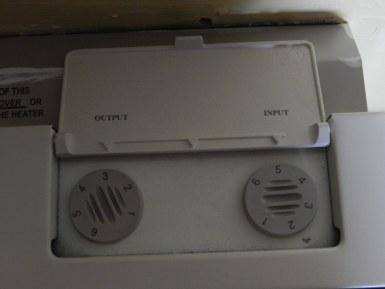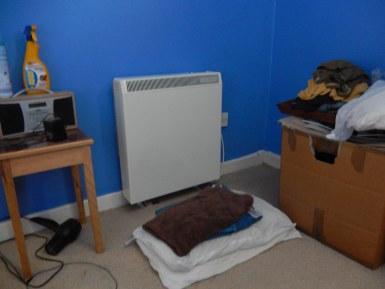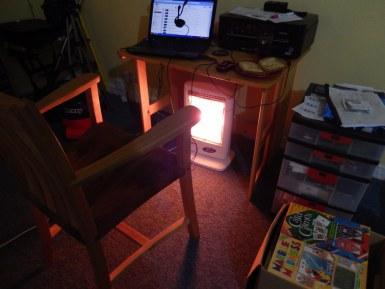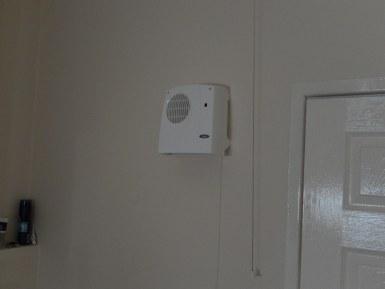My current home is one where just about everything (except for the water supply, perhaps) is powered by electricity. There is no gas supply and no oil tank to refill. Calor gas bottles are not even an option. If it doesn’t plug in to a socket or cannot be wired in to a wall then I cannot use it.

Essentially, I live in a property that lacks what is commonly regarded as central heating. In this post, I’ll be sharing my survival techniques.
As you may be aware from posts dating back around twelve-months or so, my primary source of heating comes from night storage heaters. These have a pretty bad reputation and it’s not hard to see why, in a world where just about everything is now available ‘on demand’. In case you’re unaware; they typically work by storing heat overnight and then, without using further electricity, this stored energy is released during the day. Typically, you will also have what’s known as an Economy 7 plan with your energy provider, which means you pay a reduced rate for your electricity usage for seven-hours overnight. Typically, this is between midnight and 7am but it’s worth checking with your provider.

With storage heaters, you can control the amount of heat to be stored overnight and then the rate at which it is released the next day. Heated coils (quite like an electric oven) reside inside the unit and in front of them you’ll find large blocks or bricks which initially hold on to the heat. The greater the input, the more heat you’ll have the next day and the more it will cost you. By setting the output high, the heater will emit and radiate the warmth at a faster rate. It’ll warm your room more quickly but then, you can find the supply dwindling by the time night comes.
My living room is large and has high ceilings and so, it does require a lot of energy to heat it fully. But I still find this heater is a little ineffective in this respect. That is why, at this time of the year, I restrict the input to nothing greater than 5 and leave the output to run at 3 all day (also see photo above). I believe in heating yourself where you cannot sufficiently heat your space (and I’ll get to that in a moment) – that’s why I keep it high but without paying a little extra for the maximum setting.

Both here and in the bedroom, I find the output needs to be at least 3 for me to avoid feeling the chill at 5.30 on a weekday morning. An output of 2 is more inline with spring and autumn temperatures. But I reduce my input in the bedroom because I do not ‘live‘ in that room and therefore believe it would be futile (not to mention costly) to attempt to maintain a constant high temperature all day. This allows me to get up in the mornings, especially at a time of the year where I really don’t want to. I dislike returning to a cold bed at the end of the night but I have a way to work around that.

When you read negative comments about night storage heaters, they typically refer to the fact that you almost need to be able to anticipate the next day’s temperatures and that they’re not as easily available at the flick of a switch, unlike other methods of heating (some storage heaters, however, do come with built-in fan or convection heaters). One of the strangest criticisms I’ve read is that you pay a higher rate of electricity during the daytime – but that’s just someone’s attempt to fool you with their wording. You have access to paying a reduced rate at night time, which is typically when I also charge my phone and camera batteries. By comparison to that; yes, you are paying a higher rate during the day but I only imagine this rate to be inline with what others pay in homes heated by gas, oil or even wood. There’s also a concern that they ‘waste‘ overnight by expelling whilst storing – but surely, if it’s combating the cold as it begins to set in then you’re only better prepared for a less-chilled start to your day?!
At this time of year, I seem to be spending about £70 on electricity. Taking in to account that this includes all of my heating, lighting and hot water needs… I think that’s alright. I mean, I once lived in a place where I would spend £50-100 a month on gas alone! In my situation, I wouldn’t call it comfortable living at this time of year but it is bearable.
“If you can’t heat your home, heat yourself.”
As I mentioned a little further back; I have a few tricks for keeping myself warm in the evenings, after work and as the heater’s energy is beginning to deplete.

I was introduced to halogen heaters when my mother bought me one back in 2007, I seem to remember. Back then, it was a cheap means of keeping me warm in my garage workshop and I certainly used it for a while. But then, I got myself an oil-filled radiator and found that was better at heating the entire space and not just the small section I was standing in. Those radiators aren’t quite as expensive as an immediately-effective fan heater but, from all of my research, past and present; halogen heaters appear to be the cheapest to run of them all, with costs apparently as low as 5p per hour on the lowest (400w output) settings.
Much like my halogen oven; you switch them on and the warmth can be felt almost immediately. Along with that, they also emit a powerful glow that, I think, encourages warm feeling within your mind. I would not recommend these for heating a large space and would only advise them to be used as an ‘additional‘ heating source. In my case, the storage heaters provide the background heat. Halogen heaters can be bought for as little as £10-£20 and therefore, I would never expect one to last if used for prolonged periods every single day.
They’re lightweight and easily portable. Give it an accidental nudge or knock it over and the power cuts out immediately. You can see, above, how I like to sit mine under the computer desk while I write and watch videos. When I’m on the settee, I can again position it in front of me (see below). If I’m watching a DVD and lying across the sofa then I tend to wrap myself up in a microfleece blanket as well (Lidl, once more!).

If you do go down this route, I’d advise you to look in to the bulbs and try to determine how easy they are to change and also, to check for the availability of spare bulbs. Saying that; I’ve only recently started using this again for the first time in years but, touch wood, they’ll last a while yet. These are simply cheap enough to dispose of and replace when that time does come but I like to encourage people to stray away from this Throwaway Society that surrounds us.
One lesson I learned in December 2007 – do not leave a glue bottle in front of a halogen heater for an extended period of time! Most heaters come with three output settings (400w, 800w, 1200w) but I’m typically keep mine on the lowest as it’s close by. I’m intending to buy a second one for the bedroom, as this works well to keep the chill off and allows me to change and jump in to bed without a shiver.

I did briefly mention oil-filled radiators earlier and, when I moved here, two of these were already available with thanks to the landlord. They are much better at heating a space but again, that comes with a higher cost. Until I recently regained my halogen heater, I was using one to pre-heat the bedroom prior to sleep. They’re a good option for workshops and not a bad choice for emergency homes in a room without any. But, as you see above; these two no maintain a separate purpose altogether and it doesn’t cost me a penny!

You’d do well to find a rental property like this with a permanent heating fixture in the bathroom. There is a design of storage heater specifically for wet and humid environments but is it really necessary when you’re only likely to be in there for a few minutes at a time? Landlords, in the UK, have a duty to supply something and that’s why I have the fan heater that you can see above. I would never run it for an entire day, due to the running costs but I wouldn’t be without it, either. Before having a shower, I switch it on for five minutes and it makes even this cold room bearable enough for me to undress, wash and then step out from the shower again.
I think those are all of my bases covered as far as heating is concerned. You’re probably already aware that I use a halogen oven for cooking and, for what it’s worth, the electric shower is warm and can be hot if I want it to.
Thanks for reading and I welcome any comments or suggestions. I’ve been thinking about doing a ‘10 Ways to Keep Warm in Winter‘ but we’ll see!
